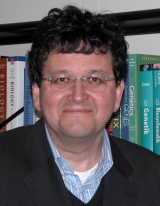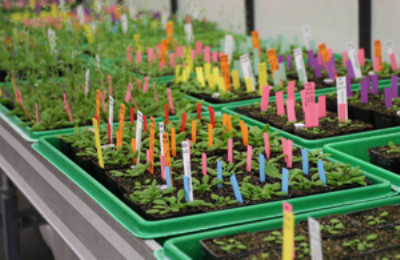Efficient plant breeding without transgenic seeds as end products – this is the objective pursued by an international consortium of researchers coordinated by the KIT botanist Professor Holger Puchta. For the first time now, the scientists want to use latest findings about the exchange of genetic information under the “RECBREED” program. The project started in March is funded by the EU under the 7th Framework Programme for a duration of four years with a total of three million Euros.
Since the invention of agriculture, man has crossbred crops with related wild species to increase yields or improve resistances against diseases. “Traditional crossbreeding, however, requires an extremely long time and large amounts of plant material. Some wild plants cannot be crossbred with related crops at all or crossbreeding is very difficult”, explains Holger Puchta from the Botanical Institute II of the KIT.

Professor Holger Puchta, Head of
the Botanical Institute II
(Photo by: Private)
This is where the RECBREED program starts. It combines old breeding methods with new technology: “We want to facilitate the exchange of genetic information of related species, accelerate it, and make it more efficient”, says program coordinator Puchta from the KIT. For this purpose, a bundle of methods based on green genetic engineering (plant molecular biology) and new findings about genetic exchange (meiosis) is used.
Among others, individual test plants are specifically provided with foreign DNA material (transgenes). “It works like additional scissors and adhesives and considerably accelerates the exchange of genetic information”, explains Puchta. The charm of this method lies in the fact that transgenic carrier plants can be sorted out after crossbreeding. The remaining species exclusively possess the natural gene pool. “The plant on the field does not possess any foreign DNA material anymore. In contrast to classical genetic engineering, a practically natural end product is obtained”, says Puchta.
Within the framework of this challenging research project, Puchta’s institute cooperates with first-class, international partners in the field of plant research: Apart from the renowned Weizmann Institute in Israel, the Centre national de la recherche scientifique (CNRS) – a French institute for fundamental research –, and the seed manufacturers Biogemma (France) and Keygene (Netherlands), researchers from the universities of Leiden and Geneva are involved in the project. A total of 3 million Euros have been granted to the partners from funds of the 7th Research Framework Programme of the EU. About 450,000 Euros are paid to the Botanical Institute II of the KIT.
“At the moment, we are still conducting fundamental research”, says Holger Puchta, who has been dealing with DNA recombination for 20 years already and has headed the KIT institute since 2002. But research that will be based on the model plant of arabidopsis (weedy cress) in the coming years may be a milestone for the technology and its acceptance by society. Puchta hopes that the time needed for the cultivation of new plants resistant against diseases or climatic extremes will be reduced significantly: “If you need five fields today, a small greenhouse might be sufficient in 10 or 20 years’ time”, says the botanist. According to Puchta, the new technology may help to reduce widely spread concerns and reservations with respect to genetic engineering.
The Karlsruhe Institute of Technology (KIT) is the merger of the Forschungszentrum Karlsruhe, member of the Helmholtz Association, and the Universität Karlsruhe. This merger will give rise to an institution of internationally excellent research and teaching in natural and engineering sciences. In total, the KIT has 8000 employees and an annual budget of 700 million Euros. The KIT focuses on the knowledge triangle of research – teaching – innovation.
The Karlsruhe institution is a leading European energy research center and plays a visible role in nanosciences worldwide. KIT sets new standards in teaching and promotion of young scientists and attracts top scientists from all over the world. Moreover, KIT is a leading innovation partner of industry.

